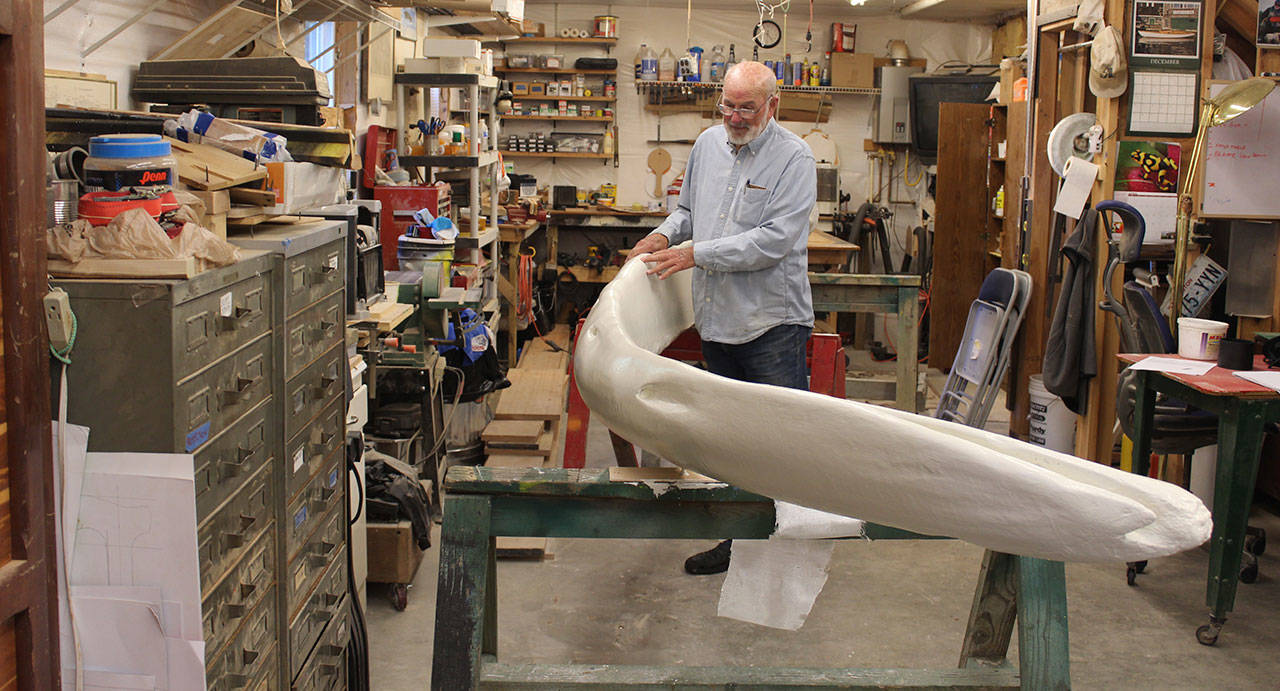Visitors to the Goss Lake home of Ken Price the past few months heard a whale of a tale about the latest project unfolding in his woodworking shop.
“They’d ask if I was working on a table or a boat and I’d say, ‘No, I’m restoring the jaw bone of a blue whale,’” he said.
One peek inside confirms he’s not just jawing.
Laid out on three saw horses is the curved, smooth 17-foot jaw bone of the largest animal on earth. The bone comprises one-half of the massive mammal’s lower jaw.
Solid, sturdy and stark white, Price’s renovation saved the big bone from deterioration and decay after years of outdoor exposure. The jaw bone acted as an arched entrance way for years into the Langley Whale Center at its two previous locations.
When the center re-located a third time last year, the century-old blue whale jaw bone was in dire shape.
“Parts of it were pulverized, and the basic integrity of the bone was not certain,” said Howard Garrett, co-founder of Orca Network that operates the nonprofit Whale Center. “It couldn’t have lasted long in the weather like that.”
The jaw bone was found in a cannery in La Conner, discovered by Monte Hughes, owner of Mystic Sea Charters. She offered it to Orca Network in 2015, Garrett said.
This particular blue whale is estimated to have been 80-feet in length, killed by whalers somewhere in the Salish Sea 100 years ago and towed to Swinomish Channel where it was flensed. No blue whales are known to be in the Salish Sea these days, Garrett said, but they are found just outside the Strait of Juan de Fuca.
Price is an accomplished woodworker and his work can already be seen inside the Whale Center. He helped in the restoration of an antique maple telephone booth that was converted into an ocean listening booth. It’s dedicated in memory of his wife, Pat Price, a long-time whale activist and center volunteer who died in 2016.
Price stepped forward in December to help save the jaw bone on one condition — that he do it alone and in the privacy of his own workshop.
“I just didn’t want people constantly coming up to me and giving me advice and asking questions,” he said. “That’s just the way I prefer to work.”
Price tackled the bone as if it were the bottom of a boat. First, all the previous paint and other repair layers were scraped off. To hold some parts in place, he pinned it together with screws and epoxy; decayed sections got a mixture of wood flour (crushed up walnuts) and epoxy resin.
“I was kind of nervous to some extent,” he admitted, “but I was confident the system would work.”
To provide a smooth finish, Price applied automotive body filler and epoxy. He then encapsulated the entire bone with 6-ounce fiberglass cloth and epoxy resin.
Next came two coats of two-part epoxy marine primer followed by two topcoats of marine epoxy paint.
Sanding was required between every coat.
“Essentially, I built a boat hull around the entire bone,” Price said.
All the steps and stabilizing required much drying time. It gave Price time to think about the wonder of repairing a part of the largest animal ever known to exist.
Bigger than dinosaurs, mightier than mastodons, blue whales were decimated by whalers and harpoon cannons. Seen in every ocean of the world, there are between 10,000 to 25,000 blue whales today — down from more than 300,000 before whaling, estimates the International Whaling Commission.
Blue whales can measure up to 100 feet in length — that’s about as long as three school buses. Its heart alone is the size of a VW bug. An average adult weighs 200,000 to 300,000 pounds.
Handling just one of its bones proved tricky. The oddly-shaped jaw bone weighs about 350 pounds. It had to be carefully loaded and secured into a truck, driven to Goss Lake, carried down a hill and somehow angled into the basement door of Price’s home. It wasn’t easy, even with a dozen eager volunteers.
“There’s no place to grab it,” Price points out. “I know it’s just an old bone but I really want to get it to the Whale Center looking like this,” he said, picking up a rag and polishing up a spot. “It reminded me of stale toast when I got it. It was porous and would crumble in your hand. If you’d stick your finger in it, your finger would disappear.”
Professional blue whale jaw bone movers have been hired to return it to the Langley Whale Center. They’re scheduled to deliver the giant jaw Wednesday morning.
A real jaw bone helps educate visitors about the blue whale’s baleen eating system, Garrett pointed out.
A long nerve runs the length of the jaw bone. Whales sense the density of swarms of small shrimp called krill and know exactly when to open their giant jaw. They engulf massive amounts of water and krill and then push water out through baleen plates.
To feel full, it’s estimated a blue whale needs 2,200 pounds of krill; it can eat four times that amount during peak consumption.
“Ken’s restoration of the jawbone has given it radiant new life,” Garrett said. “The bone is so thought-provoking on its own as a functional part of the massive blue whale anatomy and foraging strategies, and now we can focus on that and not worry about how precarious it is.”


